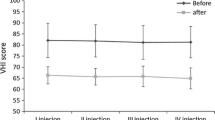Summary
To assess the efficacy of bilateral or unilateral botulinum treatments for spasmodic dysphonia we injected botulinum toxin (type A) into the thyroarytenoid muscle of 24 patients with adductor type spasmodic dysphonia. Eleven patients underwent unilateral procedures and 13 bilateral procedures. Samples of sustained phonation were analyzed acoustically by a computer-assisted method and the air flow rates determined. All tests were conducted 1 week before injection and 1 week and 1 month after treatment. With unilateral injection, improvements in acoustic parameters occurred as early as 1 week after treatment. With bilateral injections, only the voice break factor was significantly reduced after 1 week, while standard deviations of fundamental frequency, jitter, shimmer and signal-to-noise-ratios were reduced 1 month after treatment. In comparison with unilateral injections, the mean air flow rate was twice as high 1 week after bilateral injections, with no significant differences found 1 month after treatment. Clinically, both injection modes resulted in the reduction of laryngeal spasms as early as within 48 h after injection.
Similar content being viewed by others
References
Arnold GE (1959) Spastic dysphonia. I. Changing interpretations of a persistent affliction. Logos 2:3–14
Aronson AE (1990) Clinical voice disorders, 3rd edn. Thieme, New York
Aronson AE, De Santo LW (1983) Adductor spastic dyphonia: three years after recurrent laryngeal nerve resection. Laryngoscope 93:1–8
Aronson AE, Hartman DE (1981) Adductor spastic dysphonia as a sign of essential (voice) tremor. J Speech Hear Disord 46:52–58
Aronson AE, Brown JR, Litin EM, Pearson JS (1968) Spastic dysphonia. I. Voice, neurologic, and psychiatric aspects. J Speech Hear Disord 33:203–218
Aronson AE, Brown JR, Litin EM, Pearson JS (1968) Spastic dyphonia. II. Comparison with essential (voice) tremor and other neurologic and psychogenic dysphonias. J Speech Hear Disord 33:219–231
Blitzer A, Brin MF (1991) Laryngeal dystonia: a series with botulinum toxin therapy. Ann Otol Rhinol Laryngol 100:85–89
Blitzer A, Brin MIT, Fahn S, Lovelace RE (1988) Localized injections of botulinum toxin for the treatment of focal laryngeal dystonia (spastic dysphonia). Laryngoscope 96:193–197
Bloch CS, Hirano M, Gould WJ (1985) Symptom improvement of spasmodic dysphonia in response to phenatory tasks. Ann Otol Rhinol Laryngol 94:51–54
Freeman FJ, Cannito MP, Finitzo-Hieber T (1985) Getting to know spasmodic dysphonia patients. Tex J Audiol Speech Pathol 10:14–19
Kao I, Drachman DB, Price DL (1976) Botulinum toxin: mechanism of pre-synaptic blockade. Science 193:1256–1258
Ludlow CL, Naughton RF, Sedory SE, Schulz GM, Hallett M (1988) Effects of botulinum toxin injections on speech in adductor spasmodic dysphonia. Neurology 38:1220–1225
Ludlow CL, Hallett M, Sedory SE, Fujita M, Naunton RF (1990) The pathophysiology of spasmodic dysphonia and its modification by botulinum toxin. In: Berardelli A, Benecke R, Manfredi M, Marsden CD (eds) Motor disturbances II. Academic Press, Orlando, Fla., pp 274–288
Milenkovic P (1987) Least mean square measures of voice perturbation. J Speech Hear Res 30:529–538
Miller RH, Woodson GE, Jankovic J (1987) Botulinum toxin injection of the vocal fold for spasmodic dysphonia. A preliminary report. Arch Otolaryngol Head Neck Surg 113:603–605
Rabuzzi DD, McCall GN (1972) Spasmodic dysphonia: a clinical perspective. Trans Am Acad Ophthalmol Otolaryngol 76: 724–728
Robe E, Brulik J, Moore P (1960) A study of spastic dysphonia. Neurologic and electroencephalographic abnormalities. Laryngoscope 50:219–245
Schaefer SD (1983) Neuropathology of spasmodic dysphonia. Laryngoscope 93:1183–1204
Shipp T, Izdebski K, Reed C, Morrisey P (1985) Intrinsic laryngeal muscle activity in a spastic dysphonia patient. J Speech Hear Disord 50:54–79
Woodson GE, Zwirner P, Murry T, Swenson M (1991) Use of flexible fiberoptic laryngoscopy to assess patients with spasmodic dysphonia. J Voice 5:85–91
Zwirner P, Murry T, Swenson M, Woodson GE (1991) Acoustic changes in spasmodic dysphonia after botulinum toxin injection. J Voice 5:78–84
Zwirner P, Murry T, Swenson M, Woodson GE (1992) Effects of botulinum toxin therapy in patients with adductor spasmodic dysphonia: acoustic, aerodynamic and videoendoscopic findings. Laryngoscope 102:400–406
Author information
Authors and Affiliations
Additional information
Portions of this work were presented at the 63th Annual Meeting of the German Society of Oto-Rhino -Laryngology-Head and Neck Surgery, Garmisch-Partenkirchen, 30 May–3 June 1992
Rights and permissions
About this article
Cite this article
Zwirner, P., Murry, T. & Woodson, G.E. A, comparison of bilateral and unilateral botulinum toxin treatments for spasmodic dysphonia. Eur Arch Otorhinolaryngol 250, 271–276 (1993). https://doi.org/10.1007/BF00186224
Received:
Accepted:
Issue Date:
DOI: https://doi.org/10.1007/BF00186224




